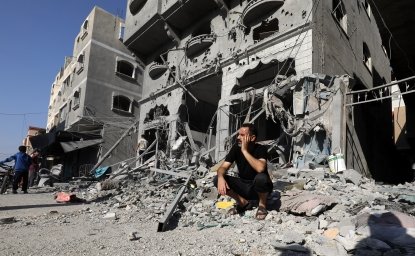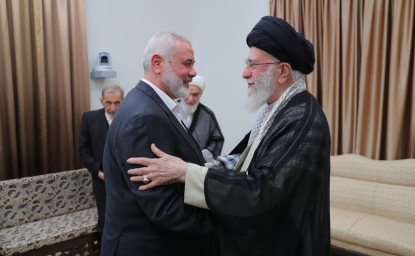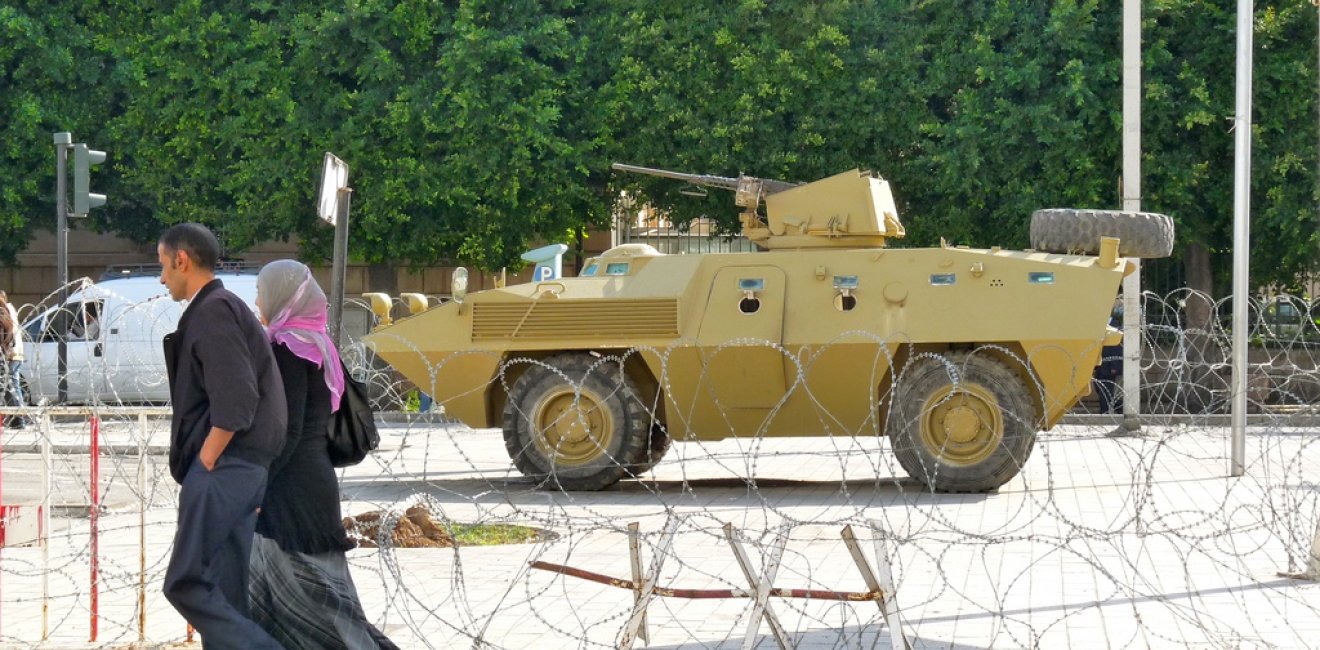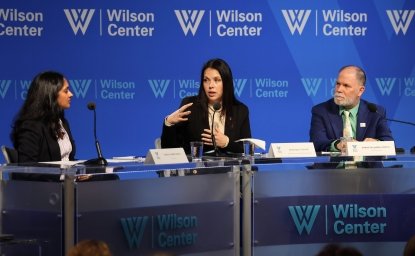Tunisia, the spark of the 2011 Arab uprisings, has had a smoother transition from dictatorship to democracy than other countries. It has faced fewer obstacles than Syria, Yemen, Egypt and Libya. Tunisia’s population is small, about 11 million. Some 99 percent of its citizens are Sunni Muslim, so it does not have the deep ethnic or sectarian cleavages that threaten to unravel Syria and Iraq. The population is also well-educated. A major divide is instead over economics and geography, notably between people on the wealthier, more developed coast and in the struggling interior.
After the Jasmine Revolution, the rift between secular and religious forces loomed over the transition. Yet moderate Islamists played a pivotal role in building a democratic system. Their party, Ennahda (Renaissance) did well in the first post-revolutionary election in 2011; it gained the premiership and more than forty percent of seats in parliament. It formed a coalition government with two secular parties. Party leader Rachid Ghannouchi said that Ennahda had always preferred a coalition government because it didn’t want Tunisians to feel “that they have moved from a single party dominant in the political life to another single party dominating the political life.”
After a political crisis, sparked by the assassination of an opposition leader in 2013, Ennahda handed over power to an interim government to organize new elections. The Islamist party lost ground. In a 2014 poll, Ennahda won about a third of seats in parliament. Its political fortune has since fluctuated.
But Tunisia’s Islamists reflect a wide spectrum, from Ennahda’s self-described “Muslim democrats” to Salafi ideologues to jihadi extremists. Affiliates of al Qaeda and ISIS have taken root since 2000. They rejected democracy and have instead sought to establish theocratic rule. Between 2011 and 2016, at least 6,000 Tunisians reportedly went to Iraq and Syria to join jihadi groups—more than any other country. Most joined the Islamic State (or ISIS). About 1,000 joined its franchise in Libya. Another 15,000 were prevented from leaving the country.
Some extremists have returned from the battlefield, posing new security risks. Since three major terrorist attacks by Islamic militants, in 2015, Tunisia has been under a state of emergency. Jihadi violence also spills over from Libya. The two countries share a 300-mile border, most of which is porous. Tunisia has become a model for reconciling Islam and democracy, but it is also a testing ground for counter-extremism strategies. Tunisia Factoids (2016):
Sources: The World Bank; CIA Factbook; The International Institute for Strategic Studies’ “The Military Balance 2017.”
Ennahda
Ennahda, or the “Renaissance” party, has its roots in the 1960s, and was forced underground in the 1980s. It reemerged after the Arab Spring. It won a plurality in the first election, in 2011, and formed a coalition government with two secular parties. But Ennahda made decisions that were unpopular with its coalition partners. It also inserted incompetent loyalists into the administration. The first post-revolutionary government focused heavily on a new constitution, especially basic rights and the role of Islam and women. More conservative Islamists called for making Sharia, Islamic law, the principal source of legislation, and some demonstrated to pressure Ennahda to take a more conservative position on the role of Islam in the constitution.
The economy also struggled. In 2013, the government agreed to unpopular conditions to receive a $1.7 billion International Monetary Fund (IMF) loan. The public increasingly associated Ennahda with economic mismanagement.
The political elite and secularists, fearing increasing Islamist influence in politics, launched Nidaa Tounes, or the “Call for Tunisia” party. It gained wider support after the assassination of two secular politicians by jihadi militants in 2013. A wide array of leftist parties, civil society organizations and labor unions formed the National Salvation Front and demanded the Ennahda-led government’s resignation and new elections.
Seeking to cut its losses, Ennahda stepped aside and joined a national dialogue. It mounted a competitive campaign in the 2014 parliamentary elections, garnering 27.5 percent of the vote, second only to Nidaa Tounes’ 37 percent. Ennahda became the second-largest party in a broad coalition that also included secularists, leftists and independents.
Ennahda and Nidaa Tounes agreed on economic reform to boost foreign investment and reduce the bloated public sector. In 2016, their unity government agreed to implement IMF economic reforms in exchange for a $2.8 billion financing package. But the austerity measures triggered protests by labor unions and opposition groups. The government has since struggled to sustain reform and retain public support.
Given its emphasis on the poor and oppressed, Ennahda has struggled to balance collaboration with secularists and maintaining an Islamic identity. Since 2015, party members have complained that it made too many concessions to other parties or remnants of the old regime. The party began to fracture.
2016 was a year of political upheaval. Ennahda founder Rachid Ghannouchi (above) declared that the party was “leaving” political Islam. “We are Muslim democrats who no longer claim political Islam,” he said. Ghannouchi said Ennahda wanted to distance itself from al Qaeda and ISIS. Meanwhile, Nidaa Tounes splintered. The main branch was left with only 62 seats in the 217-seat parliament—less than Ennahda’s 69 seats.
The strength of all parties will be tested in local elections, scheduled for March 2017 but postponed until December. It will be the first poll since Ennahda distanced itself from political Islam. Six years after the Arab Spring, the democratic government has solved few of Tunisia’s core issues. It shows. In several cities, hundreds of protestors demanding jobs clashed with police in January. In May, demonstrators targeted oil and gas facilities in the south to call for job creation. Some clashes turned violent. By 2017, unemployment, at about 16 percent, was higher than it had been before the 2011 Jasmine Revolution. Youth unemployment was at least 30 percent. Youth dissatisfaction with established parties was apparent in the 2014 parliamentary election. More than 80 percent of Tunisians between ages 18 and 25 did not vote.
Ennahda has made an effort to recruit youth, including the appointment of spokesperson Oussama Sghaier (born in 1983), and Sayida Ounissi (born in 1987), the youngest member of government. Ennahda has also recruited women for its electoral lists. Lawmakers adopted a gender-parity law governing local elections in June 2016. “The main issue of these elections is how to share power between the centralized state and regions, and also between old politicians and women and youth,” said Mehrezia Labidi, legislator and Ennahda member.
Salafis
Salafism is an ultra-conservative form of Islam; its adherents emulate the first three generations of Muslims (the Salaf). They look to the seventh century, when the faith was founded, for inspiration. In Tunisia, most Salafis are not jihadi militants. Some have chosen to participate in politics while others have eschewed it. They all support a state governed by Islamic law, which puts them at odds with Ennahda.
Jabhat al Islah (The Reform Front) has been the most active Salafi party, although it has played a marginal role in politics. It mobilized support after the Arab Spring. It ran candidates as independents in the 2011 election but failed to win any seats in the Constituent Assembly. It won legal status in 2012 but failed to win seats in the 2014 parliamentary poll. Ideologically, it has rejected violence.
Hizb al Tahrir (Party of Liberation) is part of an international movement founded in the 1980s. It calls for Islamic law and seeks to unify Muslims into a caliphate, but it rejects party politics. “Democracy no longer attracts anyone,” Hizb al Tahrir politburo chief Aberraouf Amri said at its annual congress in April 2017. “It is time to announce its death and work to bury it.” The party was legalized in 2012, despite the fact it has been banned in several Arab countries. Tunisian authorities have complained its rallies disturb public order. Opponents have tried but failed to get it outlawed.
Jihadi Salafi Groups
Jihadi Salafism marries militarism with a hardline interpretation of Islam. Jihadi Salafism in Tunisia has its roots in the 1980s, when hardline Islamists formed the Tunisian Islamic Front. Some joined the Afghan jihad against the Soviet occupation; others went into exile. All are small, numbering in the dozens or hundreds of fighters.
The Tunisian Combatant Group was formed, in 2000, by a network of extremists who sought to install an Islamist government. The group had ties to al Qaeda; members had fought in Afghanistan, Iraq and Chechnya. Seifallah Ben Omar Ben Hassine, a co-founder, was released from jail after the 2011 uprising. He soon founded a new group, Ansar al Sharia. It has been linked to both al Qaeda in the Islamic Maghreb and ISIS. It was designated a foreign terrorist organization by the United States in 2014. Ansar al Sharia has perpetrated attacks, including on the U.S. embassy in 2012, and assassinations of two politicians in 2013.
The Islamic State (ISIS) also has cells in Tunisia. In 2015, it claimed credit for the Bardo National Museum attack, a shooting near the seaside town of Sousse that killed at least 60 people, and a bus bombing in Tunis targeting presidential guards. Tunisia declared a state of emergency after the bus bombing. In March 2016, militants attacked police and military positions in Ben Guerdane, near the Libyan border, in an unsuccessful attempt to take the city. In May 2017, Tunisian security forced killed a senior ISIS leader allegedly plotting attacks during the holy month of Ramadan.
The Okba ibn Nafaa Brigade is linked to al Qaeda in the Islamic Maghreb. It has primarily attacked security forces, beginning in 2012, in the Mount Chaambi region near the Algerian border. ISIS claimed the Bardo attack, but Tunisian security officials implicated the Okba ibn Nafaa Brigade. The conflicting reports may be linked to a cell of fighters who split and pledged allegiance to ISIS in 2014. Security forces say some militants have affiliations with multiple jihadi groups.
The Challenge
Since 2011, Tunisia has navigated a rocky transition by allowing peaceful parties—both Islamist and secular—political space. In the future, it is likely to face a disproportionate threat from extremists, despite extensive steps to counter the jihadi threat.
In 2015, President Beji Caid Essebsi signed an anti-terrorism bill into law. It allowed the death penalty for convictions on terrorism charges. Amnesty International and seven other human rights organizations criticized the law. It “grants security forces broad and vague monitoring and surveillance powers, extends incommunicado detention from 6 to up to 15 days for terrorism suspects, and permits courts to close hearings to the public and allow witnesses to remain anonymous to the defendants,” they said.
In 2016, Tunisia completed a 125-mile barrier along the 300-mile border with Libya. Border security has paid off. In March, security forces repulsed an attack by dozens of ISIS-affiliated fighters in the border town of Ben Guerdane. Clashes lasted for days; 49 terrorists were killed and nine were captured. The attackers were Tunisians trained in Libya. In the first ten months of 2016, Tunisia dismantled 160 jihadi cells—45 percent more than in 2015. It also arrested 850 terrorism suspects—a 55 percent increase over 2015. The Interior Ministry reported that 3,576 Tunisians were tried on terrorism-related charges in 2016.
In November 2016, Tunisia adopted a new National Counterterrorism Strategy praised by the European Union as “an inclusive approach that involves civil society players and respects the country's constitutional principles as well as the international standards on human rights and fundamental freedoms.” Tunisia allocated 20 percent of its 2017 budget to security.
But small clashes between militants and security forces continued. In April, security forces killed two men in Sidi Bouzid suspected of having links to ISIS and the Obka ibn Nafaa Brigade. They were allegedly plotting attacks during Ramadan. Despite the government’s efforts, none of the major groups have disbanded. By December 2016, some 800 fighters had returned to Tunisia. Security forces called for the adoption of “exceptional measures” to prevent the “Somalization” of the small North African country.
“The real difficulty lies in identifying them, because many don’t return through the airports with official documents,” said Mokhtar Ben Nasr, a retired colonel, in May 2017. He said the government’s plan is to jail the most dangerous returnees and monitor others. Tunisia also attempted to prevent radicalization through counter-messaging and educational programs. It replaced imams deemed extremist. But Tunisia had no formal deradicalization program, prisons were full, and courts were backlogged with terrorism cases. Tunisia’s transition—especially its experiment with the many shades of Islamist politics—is far from over.
Garrett Nada is the managing editor of The Islamists at the U.S. Institute of Peace.
Photo credits: Rachid Ghannouchi via Ennahda Party licnsed under Creative Commons Attribution Generic (CC BY- ND 2.0) ; Tunisia street by Stefan de Vries licensed under Creative Commons Attribution- NoDerivs 2.0 Generic (CC BY- ND 2.0)
Author


The Islamists
Learn more about Hamas and how it relates to similarly aligned organizations throughout the region. Read more

Explore More
Browse Insights & Analysis
Israel Escalates Attacks in Gaza: What’s Next?

Israel Expands Operations on Multiple Fronts: Perspectives on the Conflict


